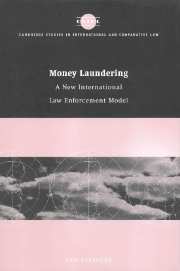Book contents
- Frontmatter
- Contents
- Preface
- Table of treaties and agreements
- List of abbreviations
- Part I New instruments in the fight against acquisitive crime: confiscation of proceeds from crime and criminalisation of money laundering
- 1 The background of the fight against money laundering
- 2 The confiscation
- 3 The fight against money laundering: genesis of a new crime
- Part II The prevention of money laundering
- Part III Jurisdiction over money laundering
- Part IV International co-operation in combating money laundering
- Epilogue
- Bibliography
- Index
- CAMBRIDGE STUDIES IN INTERNATIONAL AND COMPARATIVE LAW
1 - The background of the fight against money laundering
Published online by Cambridge University Press: 16 October 2009
- Frontmatter
- Contents
- Preface
- Table of treaties and agreements
- List of abbreviations
- Part I New instruments in the fight against acquisitive crime: confiscation of proceeds from crime and criminalisation of money laundering
- 1 The background of the fight against money laundering
- 2 The confiscation
- 3 The fight against money laundering: genesis of a new crime
- Part II The prevention of money laundering
- Part III Jurisdiction over money laundering
- Part IV International co-operation in combating money laundering
- Epilogue
- Bibliography
- Index
- CAMBRIDGE STUDIES IN INTERNATIONAL AND COMPARATIVE LAW
Summary
The fight against money laundering aims at a more effective enforcement of the criminal law in relation to profit-oriented crime. This chapter seeks to clarify the background of this fight. It will be shown that the introduction of the two main legal devices that are used in the fight against money laundering, the confiscation of the proceeds from crime and the incrimination of money laundering, are closely linked to changes that occurred on a legal and a socio-economic level. These criminal law instruments have, however, created a momentum of their own. The most important example of how the fight against money laundering has separated itself from the background that gave rise to it is the drastic expansion of the application field of the confiscation of the proceeds from crime and the incrimination of money laundering itself. Whereas the scope of these instruments was originally limited to drug offences or offences related to organised crime, it has now been drastically expanded to cover other, if not all, types of offences. In addition, the international fight against money laundering also signifies an evolution of the norm-making process in the field of law enforcement law.
Legal background
Pecunia non olet, money does not stink. For a long time this seems to have been the prevailing attitude of most criminal justice systems and, in a sense, of most societies in general, towards proceeds from crime. Until quite recently, most criminal justice systems – implicitly if not explicitly – allowed offenders to enjoy the fruits of their crimes. This attitude should be set against the backdrop of the type of offences that criminal courts traditionally had to deal with.
- Type
- Chapter
- Information
- Money LaunderingA New International Law Enforcement Model, pp. 3 - 28Publisher: Cambridge University PressPrint publication year: 2000

